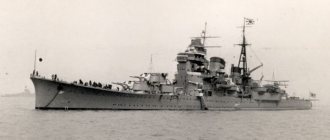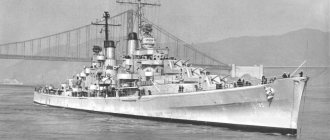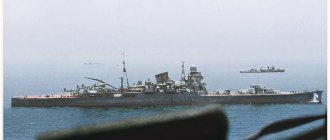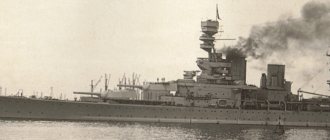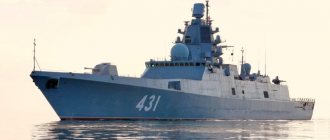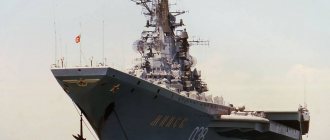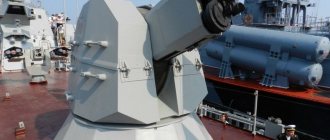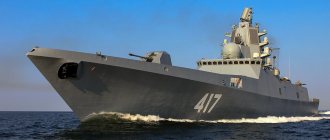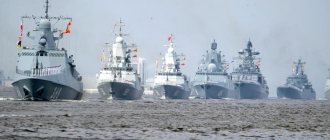Characteristics of heavy cruisers of the B-64/65 project
A country:JapanType:Battle cruiserDate of issue:The project was closed in 1941.Displacement:Normal: 32,000 tons, full: 34,800 tons.Length:246 metersWidth:27.2 metersDraft:8.8 metersReservations:Armor belt: 190 mm, deck: 125 mm.Crew:1500 peoplePower point:4 turbines, 8 boilersTravel range:8000 milesMaximum speed:33 knotsWeapons:9x310 mm (3 turrets of 3 guns each), 16x100 mm (8 turrets of 2 guns each), 12x25 mm (4 turrets of 3 guns each), 4x13 mm (2 turrets of 2 guns each), 2 four-tube torpedo tubes with a caliber of 610 mm.Air group:3 seaplanes.
Soon after the outbreak of the Second World War in Japan, it became known about the design of super-heavy, “large” Alaska-class cruisers underway in the United States with 305 mm guns and a speed of over 30 knots, the response to which was the “A-class supercruisers,” as they were officially called in the Japanese Imperial Navy.
Another reason for the appearance of this project was the desire of the fleet to receive new powerful and high-speed artillery ships to replace the already outdated ones, despite all the modernization of the Kongo-class battleships, which had been in service for more than 25 years.
Submarine force composition
The commander of the submarine force has the rank of vice admiral and commands the following military units:
- headquarters at Yokosuke base;
- two flotillas with submarines located there and at the Kure base;
- submariner training center and training division.
Each flotilla is under the command of a rear admiral, to whom all military personnel at headquarters, on the flagship submarine mothership, and in two or three submarine divisions (each includes 3-4 submarines) are also subordinate.
Tasks of the Japanese supercruiser
However, the operational plans of the naval general staff also assigned an important role to the old battleships. According to these plans, the 3rd division of battleships (ships of the "Congo" type) represented the core of the 2nd fleet, the so-called "Night Combat Formations". On the night before the general battle, this formation was supposed to attack the main enemy forces. The 3rd battleship division and the 4th cruiser division (Takao-class heavy cruisers) were supposed to break through the outer guard ring of the enemy battleships, consisting of heavy "Washington" cruisers, after which the 5th and 7th cruiser divisions took over (heavy cruisers of the Myoko and Mogami types), a division of torpedo cruisers and a 16-ship destroyer squadron.
The Kongo-class fast battleships generally corresponded to the tasks assigned to them: they had powerful artillery and high speed, not much inferior in this respect to enemy cruisers and destroyers. However, their armor was clearly insufficient; for example, the vertical armor remained unchanged from the moment the ships were put into operation, and at actual combat distances it could only withstand fire from heavy cruisers. Therefore, work on large cruisers in the United States required an immediate response from the Japanese side.
Japan: Navy (structural composition)
The head of the Japanese naval forces is the commander, who is also the chief of staff, holding the rank of admiral.
Structurally, the Japanese Navy consists of a headquarters, a fleet, five military maritime regions, an air training command, as well as formations, units and institutions under central command. The location of the headquarters is an administrative complex in the capital of the state, where control centers for other branches of the military and the Ministry of Defense are also located.
In total, the headquarters staff includes 700 employees, of which about six hundred are officers and admirals.
The fleet consists of:
- headquarters located at Yokosuka Naval Base;
- three commands - escort, submarine and aviation;
- minesweeper flotillas;
- reconnaissance groups;
- experience groups;
- oceanography divisions;
- special forces patrol squad.
The fleet has a little more than a hundred warships. Here is a list of some items:
- diesel submarines - 16 pieces;
- destroyers - 44 pieces;
- frigates – 8 pcs.;
- landing ships - 7 pcs.;
- minesweepers - about 39 pcs.
The fleet is under the command of a vice admiral.
Design of B-64 supercruisers
The design of new cruisers began in the summer of 1940. At the same time, the first two ships were included in the “Fifth Fleet Replenishment Program of 1942-43.” under construction numbers 795 and 796, and from August they appeared in the planned composition of the 2nd Fleet instead of the Kongo-class battleships.
The preliminary design of the basic B-64 design was completed in September 1940. (Projects for battleships were designated by the letter "A", battlecruisers - "B", heavy cruisers - "C", etc., and the number indicated the development number.) The new ships had much in common with the Yamato-class battleships: hull shapes , general location, reservation system, torpedo protection, superstructure that made even their silhouettes similar.
The Project B-64 supercruiser was called the “lightweight Yamato.” The similarity with this battleship can be seen even in its outline.
The contours of the smooth-deck hull corresponded to those adopted by the naval technical department, which were proposed in 1930 by Captain 1st Rank Fujimoto when designing contract battleships.
The hull reached its greatest width somewhat aft from the middle of the ship. The height of the freeboard in the bow was determined by the requirements of high seaworthiness, in the middle part - by the necessary reserve of buoyancy and stability, in the stern - the least possible in order to save weight. The main structural elements that ensured longitudinal strength were three decks, of which the middle one was armored, three platforms at the ends and an armor belt included in the power structure of the hull.
Throughout the boiler rooms and engine rooms, the lower platform turned into a triple bottom, which was not the case on the Yamato-class battleships and which distinguished the cruisers of the B-64 project for the better. To reduce water resistance, the bow received a special, rounded shape.
Structure of other groups
The experience group is commanded by a rear admiral.
The composition of the unit is as follows:
- headquarters in Yokosuka;
- vessel division;
- three centers: the first - for the development and design of ships, the second - for control and communication systems, the third - a testing laboratory for ship weapons with a testing ground in Kagoshima.
The ocean group, in addition to the headquarters, anti-submarine defense center, meteorological support group and two coastal sonar stations, also includes ships for hydrographic research, hydroacoustic observations and cable-laying ships.
The intelligence group includes a headquarters and three departments (for collecting operational information, conducting information and analytical activities, and reconnaissance by radio-electronic means).
The special purpose patrol squad has the following tasks:
- detain and inspect ships violating territorial coastal boundaries;
- fight terrorist and sabotage groups;
- conducting reconnaissance activities and sabotage.
Armor and armament of B-64 cruisers
According to the initial requirements, the reservation system had to withstand fire from 305-mm guns from a distance of 20,000 - 30,000 m, and also withstand hits from 800-kg (later 1,000-kg) bombs dropped from a dive.
Its general design largely corresponded to that adopted on Yamato-class battleships. The armor belt, 190 mm thick, installed with an outward slope of 20°, which significantly increased its effective thickness, covered 59% of the length of the ship along the waterline (from the bow to the stern main caliber turret). At the ends it ended with armored traverses, which may also have been installed at an angle. An armored deck 125 mm thick rested on the upper edge of the belt. The barbettes of the main caliber towers above the level of the armored deck were supposed to have a thickness of 250 mm, the frontal plates of the towers - 200 mm, and the side plates - 150 mm. The thickness of the walls of the conning tower was determined to be 200 mm. In addition, in the stern there were two well-armored rooms for the main and auxiliary steering engines.
The anti-torpedo protection had to withstand the contact explosion of a 400 kg trinitrotoluene charge, which was a standard requirement when designing capital ships in the Imperial Japanese Navy, as well as underwater hits from 305 mm shells.
The basis of the anti-torpedo protection, as on the Yamato, was a single powerful armored anti-torpedo bulkhead, which was a continuation of the main armor belt. However, the placement of boiler rooms and engine rooms in a longer and narrower body, different from Yamato (four engine rooms in two rows of two compartments along the center plane and eight boiler rooms in two rows of four compartments also along the DP), made it possible to install the bow cellars of the main caliber, boiler rooms and engine rooms had another watertight bulkhead, which was an important improvement. It would prevent water from filtering through the broken main bulkhead in the event of damage to the PTZ and flooding of the engine and boiler rooms, which was observed on the Yamato and Musashi.
It was planned to install new 310-mm guns with a barrel length of 50 calibers as the main armament on the battlecruisers of the B-64 project. A special feature of this gun was the use of a very heavy (561 kg) armor-piercing projectile, which could effectively penetrate both vertical and horizontal armor at various combat distances. The maximum firing range was 32,920 m at an elevation angle of 45°, and the rate of fire was 3 rounds per minute. The total supply of shells (540 pieces, 60 per gun) was fully consistent with the standards accepted in the Japanese fleet.
Considering the specifics of the planned use of these ships, this amount of ammunition was quite enough for a fleeting night battle. The fire control system included two 10-meter rangefinders on the bow and stern superstructures and three more rangefinders in each of the main caliber turrets, two Type 98 directors in closed turrets above the rangefinders mounted on the superstructures and a computing device with a target tracking device.
The auxiliary caliber consisted of eight two-gun turret mounts of the new 100 mm "type 98" universal guns. This gun was an excellent air defense weapon, and in terms of ballistic characteristics (initial speed 1000 m/s, firing range 19500 m) and rate of fire (15-20 rounds/min) it was superior to the universal 127-mm gun “type 89”, which then provided long-range air defense of almost all ships of the Japanese fleet.
To control the fire of the universal guns, four stabilized aiming posts of type 94 with 4.5-meter rangefinders of type 89 and an anti-aircraft fire control device of type 94 served. The near air defense zone was covered by four paired, later built, 25-mm machine guns with two sighting sights of type 95 and two coaxial 13 mm machine guns.
The cruisers' armament was supplemented by two deck-mounted four-tube 610 mm torpedo tubes, as well as three onboard seaplanes and one catapult.
Total information
In total, a little more than 45.5 thousand military personnel and 3.7 thousand civilians serve in the Japanese fleet. Of these, 8,000 are part of naval aviation. 1,100 volunteers who left military service at the end of their contracts or length of service are assigned as a permanent reserve. About 12 thousand people work in the Maritime Safety Authority (MSD).
As a small island state, Japan has a fairly powerful fleet. The Navy, photos of individual units of which can be seen in the article, is armed with an impressive number of ships and submarines. The warships of the main class are made up of squadrons based mainly at the main naval base of Yokosuka.
- The squadron with escort ships includes four flotillas where destroyers are assigned.
- The submarine division includes 2 groups of submarines.
- In addition to the Yokosuka base, two flotillas of minesweepers are based at the Kure naval base.
- Flotillas engaged in the protection of coastal waters are stationed at military bases: Yokosuka, Kure, Sasebo, Maizuru and Ominato. There are only five such units. This includes obsolete destroyers and frigates, landing ships, combat boats, and auxiliary vessels.
Recruit training is carried out on training ships.
The Japanese Navy today includes a total of 447 units of various types of ships and submarines. These are combat and patrol ships, boats and support vessels, located, as already noted, at the main naval bases - Yokosuka, Sasebo, Kyure, and auxiliary ones - Maizuru, Ominato and Hanshin.
The Japan Maritime Self-Defense Force also maintains aviation. These are airplanes - 190 units, and helicopters - 140 units. Of these, 86 are P-3C Orion patrol and anti-submarine aircraft, as well as 79 SH-60J Seahawk helicopters.
Cruiser power plant
The power plant was supposed to consist of eight boilers and four turbo-gear units (all of the Kanpon type), with a total shaft power of 170,000 hp. would allow us to achieve the required speed of 33-34 knots. As noted above, in accordance with Japanese practice, all boilers and turbine units were located separately, each in its own compartment. The steering included two rudders, an auxiliary one in front of the main one, and two steering gears in separate compartments located quite far from each other.
Air force structure
The location of the air command is Atsugi Air Base.
Structurally, it consists of the following divisions:
- headquarters;
- seven air wings;
- three separate squadrons;
- three detachments: two aircraft repair detachments and an air traffic control detachment;
- one mobile engineering company located at Hachinohe Air Base.
The commander of the aviation forces bears the rank of vice admiral. The chief of staff and air wing commanders are rear admirals.
Aircraft wings consist of:
- headquarters;
- four squadrons: patrol, search and rescue, anti-submarine helicopter and electronic warfare units;
- engineering and aviation support and supply groups;
- airfield technical support units.
The 31st Air Wing is subordinate to a special detachment containing unmanned aerial vehicles-targets. An aviation squadron has one to three aviation and technical detachments. The air patrol squadrons located in each air wing are armed with P-3C Orion base aircraft. SH-60 models are deployed in squadrons with anti-submarine helicopters. Search and rescue squadrons have up to three squadrons with UH-60J helicopters.
Development of the B-64 cruiser project
When the main characteristics of the Alaska-class cruisers became known in Japan at the end of 1941, the technical department of the fleet prepared a B-65 project with six 356 mm guns in two-gun turrets and enhanced protection that could withstand fire from 356 mm guns . However, due to the increase in displacement and deterioration in driving performance, increased protection had to be abandoned.
Due to the outbreak of the war in the Pacific, all work on the B-64/65 project was stopped, and orders for the construction of supercruisers were never issued. In 1941, the command of the Japanese fleet discussed the “Sixth Fleet Replenishment Program.” As a result of this discussion, it was proposed to build four battle cruisers within the framework of the Program, similar in technical data to the B-65 project, but this issue was only at the research stage and did not receive further development.
In general, the B-64/65 project was quite good within the given specifications and, in comparison with other projects of similar ships, was well balanced. It combined significant offensive power, high speed and good anti-tank protection, significantly superior to what the American cruisers Alaska had.
Armor protection made it possible to deal with heavy cruisers and equivalent enemy ships without any complications. If these ships were built, their place in the fleet’s combat schedule would most likely change, the reason for this would be many factors: the growing role of aviation, the appearance in the enemy fleet of high-speed battleships that had a speed comparable to the new battlecruisers, etc. It is most likely that they would take the place of a half-division of Kongo-class battleships as part of the escort of an aircraft carrier strike force. The high speed and numerous anti-aircraft artillery of these ships would be used here, and the powerful main caliber guns would serve as reliable protection in the event of a collision with the enemy.
• Navy Directory • Japanese Navy • Warships of the same period •
Destroyers[edit]
1st class destroyers[edit]
- Urakaze class (1915) Urakaze
- Kavakadze
- Isokaze
- Kanran (HMS Nemesis
)
)
- Kavakadze
- Minekaze
- Asakadze
- Fumizuki
- Akebono
- Akatsuki
- Ariake
- Harusame
- Rare
- Akigumo
- Akishimo
- Akizuki
(not completed)
- Shimakaze
- Hinoki
- Azusa
(not launched)
(not launched)
(not completed)
(not launched)
(not launched)
(not completed)
(not launched)
(not completed)
(not completed)
2nd class destroyers[edit]
- Sakura class (1911-1912) Sakura
- Tachibana
- Kaba
- Momo
- Enoki
- Momi
- Wakatake
3rd class destroyers[edit]
- Murakumo class (1898–1922) Murakumo
- Shinonome
- Yugiri
- Shiranui
- Kagero
- Usugumo
- Ikazuchi
- Akatsuki
- Shirakumo
- Harusame
- Kamikaze
External links [edit]
- MaritimeQuest Japanese Destroyer Index
- Review of MaritimeQuest Akatsuki class destroyers
- Review of MaritimeQuest Akizuki class destroyers
- Review of MaritimeQuest Hatsuharu class destroyers
- Review of the MaritimeQuest Matsu class destroyer
- Review of MaritimeQuest Minekaze class destroyers
- Overview of the MaritimeQuest Kamikaze class of destroyers
- MaritimeQuest Japanese Battleship Index
- Japanese gunboats in Japanese, with photos
- Japanese gunboats in Japanese, with photos
- IJN materials
- Monograph 144 Chapter II
Torpedo boats[edit]
- Shirataka class (1899–1923) Shirataka
- Hayabusa
- Chidori
- Hato
The inglorious end of battleships
For most of the war, the Yamato-class battleships stood idle near the island of Truk. They didn't have a single chance to show all their firepower. In 1943, the battleship Musashi sailed to the Aleutian Islands, and in 1944 both ships were deployed off the Philippines, in Leyte Gulf.
It was there that the battleship Musashi sank on October 24, 1944. In this battle, all the shortcomings of battleships with enormous firepower became apparent. All of it became completely useless when it came to air raids. The battleship was an easy target for fighters and bombers; it was shot at as if in a shooting gallery. In the complete absence of an air defense system, there was simply nothing to respond to, and there was not a single aircraft carrier in the squadron accompanying him.
During six air raids, the Japanese squadron was completely sunk: 23 destroyers, 11 cruisers and 7 battleships. "Musashi" received from 16 to 20 torpedoes and up to 17 heavy bombs.
The same fate befell the battleship Yamato on April 7, 1945 near Okinawa, where it returned accompanied by one cruiser and seven destroyers. They had to help repel the American landing, sacrificing themselves for this. The ships did not reach Okinawa; they were discovered earlier and attacked from aircraft carriers.
227 carrier-based aircraft took part in the air raid. In two hours, the battleship was hit by about a dozen torpedoes (all on one side) and about 13 heavy bombs. The Yamato tilted, the displaced 460-mm shells on board exploded, after which the ship sank along with 3,063 crew members; only 269 managed to escape. Losses on the American side amounted to 47 aircraft.
Large-scale disasters also occur with civilian ships. Some of them even surpass in scale the sinking of the Titanic .
